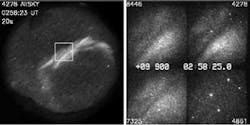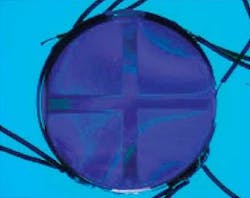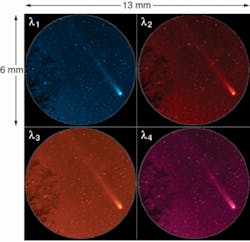MULTISPECTRAL IMAGING: Segmented tunable filters advance multispectral imaging
JOHN NOTO, MICHAEL DORIN, AND JOSHUA SEMETER
The study of transient atmospheric and environmental events has been gaining in importance since the discovery of sprites in 1989 and as observation platforms increasingly transition from ground to space. A sprite is an electro-optical discharge that occurs above the clouds during a thunderstorm, commonly described as “unusual or upward lightning,” often with an intricate, tree-like structure. Sprites are typically only visible for a few milliseconds. Similar upper atmospheric optical phenomena include blue jets, meteor trails, and perhaps the most commonly known: aurorae. Multispectral imaging is vital to the understanding of such luminous phenomena. In addition to its use in atmospheric science and space weather, this technique is broadly applicable across other diverse fields, from biomedical engineering to national security.
While passive detection of transient atmospheric or environmental events is relatively simple, elucidating physical parameters relating to the temperature, velocity, and composition of such events is not. The requirements are demanding and the instrument must have a narrow-enough bandwidth to allow detection of atomic spectral lines characteristic of excited or ablating constituents against a bright, broadband greybody background emission. Such detection must be rapid because the lifetimes of emitting species are characteristically brief. High luminosity via fast optics is needed to accommodate the tactical need for a lightweight device with a small footprint. In addition, and particularly challenging, is the fact that the imager cannot operate only at static, predetermined wavelengths. Although candidate atomic-transition wavelengths may be well known, a mechanism to compensate for large Doppler shifts characteristic of sensor motion (orbiting, ballistic, or static) relative to the event is a must. Advances in imaging focal-plane-array (FPA) detectors and electronics have made the construction and acquisition of imaging sensors straightforward, but having an appropriate dispersing element is key to the system’s success.
Many devices are available that can simultaneously collect spatial and spectral information, but most are either limited by inadequate spectral resolution for background discrimination, or are unable to accommodate for Doppler shifts from prescribed narrowband emission wavelengths. An innovation is needed that provides high spectral resolution (for background discrimination) and rapid tuning over a dynamically possible range of Doppler shifts.
Traditionally, spectral imaging designs use a suitable array detector behind fast optics and either static narrowband filters to isolate spectral regions of interest or a diffraction grating used as a dispersive element. The narrowband-filter approach offers the highest luminosity and true two-dimensional imaging, but lacks true multispectral simultaneity, as a filter wheel or cartridge containing multiple filters is needed to collect images at different wavelengths. A grating-based system is better but only images in one dimension. As the other dimension contains the spatial information, this limitation necessitates a scanning mirror or “pushbroom” approach to image a two-dimensional scene.
A “pushbroom” system is essentially a grating spectrometer in which either a movable mirror or the motion of the vehicle carrying the spectrometer (aircraft, satellite, and so on) sweeps the entrance slit over the region of interest. Linear spectra are then reconstructed into a data cube. The advantages of this type of system are broad wavelength coverage and the ability to control spectral resolution by manipulating slit width. These imagers suffer from the inherent inefficiency of a grating system and can take a long time to create a full data cube as the throughput is limited by both the grating efficiency and slit size.
Recent developments have explored the use of chromotomographic imagers. These imagers disperse the spatial and spectral information over an entire FPA and then reconstruct the data cube computationally. The three-dimensional spectral image is reconstructed using tomographic techniques. While this technique has advantages of throughput (through use of either a prism or grating but no slit) and simultaneity, several aspects are lacking. If the image data is corrupted or lost via transmission dropouts, reconstruction of the data cube is impossible. With other types of spectral imagers, a small data loss only represents small holes in the data cube.
The most common multispectral imager is the direct-imaging spectrometer or spectrophotometer. This device typically creates a data cube from a set of images obtained through several narrowband interference filters in a filter wheel. These systems have the advantage of high throughput and ease of interpretation and analysis. The disadvantage is that static filters with fixed center wavelengths drift with age and temperature.
The Simultaneous Multispectral Imager (SMI) at the Sondrestrom Upper Atmospheric Research Facility in Greenland is a direct-imaging spectrometer that serves as a high-speed narrow-field digital auroral camera with two modes of operation. The multispectral mode images a single field at four wavelength bands simultaneously, with 1 km spatial resolution and a typical time resolution of 1 s. The single-channel mode images a single field through a larger than 640 nm edge filter at 0.3 km spatial resolution and 40 ms time resolution. The SMI is at its heart a conventional narrowband wide-field imager with an array of four prisms or wedges that redirect the collimated beam prior to the reimager to create four images at the focal plane. Narrowband interference filters define the static wavelength bands (see Fig. 1).
A new type of segmented tunable filter overcomes these limitations when incorporated as the key dispersive element in a hybrid multispectral imaging system. Based upon Fabry Perot technology, this next-generation tunable optical filter has multiple independently tunable filter segments on a single substrate. This recently patented technology enables multispectral imagers to generate small but dense data cubes of narrow-bandwidth spectral images.
The classic Fabry-Perot (FP) interferometer, or etalon, is a pair of highly polished mirrors that face one other across a given distance, creating a resonant cavity. Light of all wavelengths enters the device, reflects multiple times between the mirrors, interferes constructively, and exits the device in a bulls-eye pattern of concentric rings. These rings are separated in wavelength and dispersed radially outward from the center of the pattern as a function of angle. When used in a collimated beam, the FP acts as a tunable filter, transmitting only a single wavelength corresponding to that of the central ring, or order.Fabry-Perot interferometers have the intrinsic quality of providing high spectral resolution while preserving image quality and yielding maximum throughput for a given spectral resolution. The luminosity-resolution product of a Fabry-Perot etalon is several hundred times larger than that of a grating spectrometer with equal resolution, the so-called “Jacquinot advantage” of interferometers over grating spectrometers. An order-sorting interference filter prevents information from adjacent orders from entering (or exiting) the etalon. Using the Fabry-Perot etalon as a tunable filter in a collimated beam or with an imaging detector allows for much higher throughput than is available with a grating spectrometer. The basic version of a tunable FP system has an air-gap that is tuned by changing pressure within the resonant cavity.
The liquid-crystal Fabry-Perot (LCFP) tunable filter, in which the resonant cavity is filled with liquid crystal (LC) rather than air, is a dramatically improved version of the classic Fabry-Perot interferometer. Changing the index of refraction of the LC by applying a low-voltage electric field is effectively equivalent to changing the physical distance separating the mirrors or the pressure within the cavity. The result is a completely solid-state, robust, compact, easy-to-use, tunable optical filter with high spectral resolution and rapid, precise, stable spectral selection. The optically transparent conductive layer within an LCFP cell can be etched to define independently tunable regions, or segments (see Fig. 2). The segments are each simultaneously tunable to any wavelength within the operating range of the etalon, which is generally broad and dependent only upon the reflectivity coating of the etalon. This wavelength agility enables much more versatility than that of a traditional filter-based system.Integration of a four-band segmented LCFP into the SMI system would provide dynamic selection of each wavelength band, thus enhancing the efficacy and versatility of the instrument. Following the SMI design strategy, Scientific Solutions is building two imagers that incorporate an array of segmented tunable filters. The advantages of such an imager are true multispectral simultaneity, automatic image coregistration, and the ability to calibrate each wavelength channel simultaneously. Independent tuning of each spectral channel to a separate wavelength allows simultaneous imaging at multiple wavelengths and the creation of a data cube that will not overburden a telemetry system that transmits data remotely (see Fig. 3). Interpretation of this data is simple, immediate, and can even be automated. Multiple data cubes can be collected on time scales of kilohertz, while maintaining the high throughput of a filter-based imager.
These innovative advances allow for a multispectral imaging system that successfully blends mechanical stability, portability, high spectral resolution, high luminosity, moderate cost, and portability. The system is compact, mechanically robust, requires only a few watts of power, and is easy to set up in any given field location. The use of segmented tunable filters in multispectral imaging systems promises to break new ground in the study of transient atmospheric and environmental events while adding to the available spectroscopic tools required for general multispectral imaging applications.
ACKNOWLEDGMENTS
Scientific Solutions has received support from the Small Business Innovative Research Phase I and Phase II programs of the Missile Defense Agency for the development of the segmented tunable filter (approved for Public Release 01-MDA-2971, Nov. 19, 2007).
JOHN NOTO is president and MICHAEL DORIN is director of sales and marketing at Scientific Solutions, 55 Middlesex St., Suite 210, North Chelmsford, MA 01863; e-mail: [email protected]; www.sci-sol.com. JOSHUA SEMETER is assistant professor of electrical and computer engineering at Boston University, Boston, MA 02215; e-mail: [email protected].


